Sarkar N. (ed.) Human-Robot Interaction
Подождите немного. Документ загружается.


Automatic Speech Recognition of Human-Symbiotic Robot EMIEW
401
However, at least the steering vector of noise is not given and it is time-variable. Therefore,
the steering vector of noise needs to be estimated at the beginning and updated when DOA
of noise is changed. By Minimum Variance Beam-Former (MVBF) (Frost, 1972) , even when
the steering vector of noise is unknown, noise reduction filter can be obtained as follows:
*1
1
aaR
aR
w
−
−
=
(12)
,where R is the correlation matrix of the input vector x and is defined as follows:
[]
.
*
x
xE
R
=
(13)
MVBF needs only desired steering vector a and correlation matrix of input vectors. The
desired steering vector a can be calculated when DOA of desired source is given.
The filter w passes sources whose steering vector completely matches with given desired
steering vector a, and reduce sources whose steering vector are different from a.
However, even when DOA of desired source is given based on prior knowledge such as
``desired speaker is in front of the robot'', actually the location of the speaker is different
from given DOA. Additionally, given steering vector a is different from the actual steering
vector because of reverberation.
Therefore, in this ``steering vector mismatch case”, the filter made by MVBF cancels desired
source (signal cancellation problem). This signal cancellation problem frequently occurs
when the biggest component in correlation matrix R corresponds to desired signal. When
the biggest component in correlation matrix R corresponds to noise signal, this signal
cancellation problem does not occur. Therefore, correlation matrix R needs to be updated
when desired source is absent. However, DOA of noise is time-variable. Therefore,
correlation matrix R needs to be always updated.
To fill these requirements, time-variable coefficient to update correlation matrix R is
proposed. Conventional MVBF updates correlation matrix R as follows:
.)1(
*
1
ττττ
β
β
xxRR −+=
+
(14)
Correlation matrix R is updated with the time-invariable coefficient. However, when the
biggest source in the input vector is desired source, updating the correlation matrix R is
unfavorable. Therefore, proposed SB-MVBF (Sparseness Based Minimum Variance Beam-
Former) uses the time-variable coefficient to update correlation matrix R as follows:
*
1
))(1()(
ττττ
τ
α
τ
α
xxRR −+=
+
(15)
,where correlation matrix R is updated with the time-variable coefficient
)(
τ
α
. This
coefficient set to be 1 when desired source is likely to be inactive , and set to be 0 when
desired source is likely to be active.
Estimation of desired source’s status (active/inactive) is done by results of sound source
localization. Proposed sound source localization MDSBF can accurately estimate DOA of
sources at each time- frequency point. Therefore, when estimated DOA of one time-
frequency point is far from DOA of desired source, it is likely that desired source is inactive
in this time-frequency point.
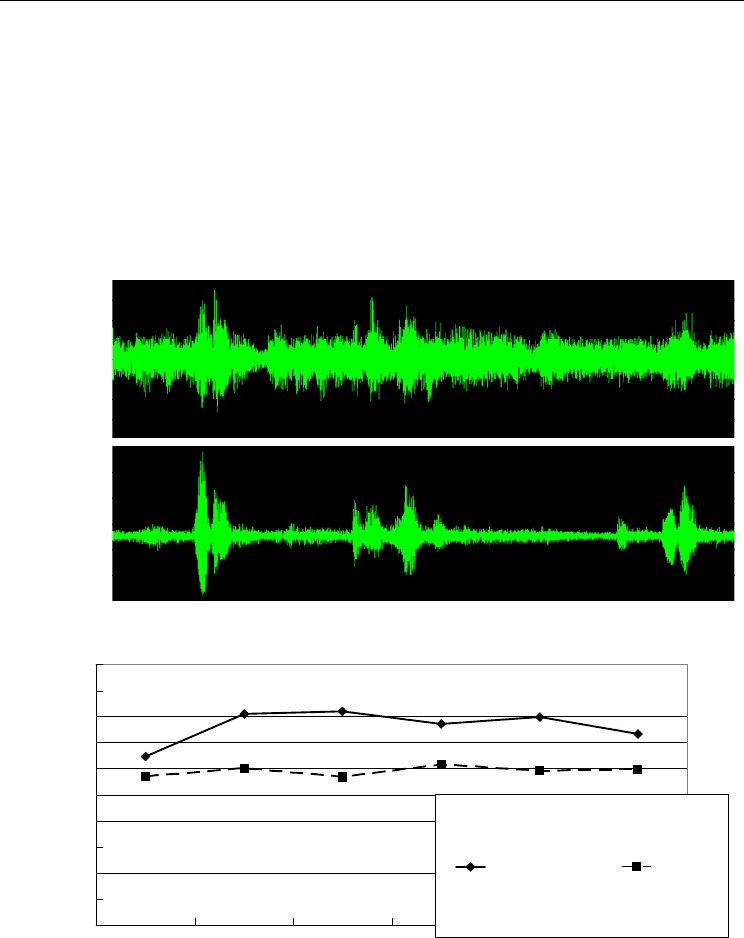
Human-Robot Interaction
402
SB-MVBF sets the time-variable coefficient to be 1 when estimated DOA by MDSBF is far
from DOA of desired source and set it to be 0 when estimated DOA by MDSBF is close to
DOA of desired source. An example of separated signal at an room (reverberation time is
300 ms) is shown in Fig. 6.
3.3 Evaluation of ASR Under Noisy Environment
SB-MVBF reduces noise. However, residual noise exists in noise reduced signal,
performance of automatic speech recognition is degraded when the acoustic model of ASR
is made by clean speeches. Therefore the acoustic model is adapted by speeches convolved
with remained noise. In this experiment, the acoustic model is adapted to noise reduced
signals by the proposed method.
Input
Signal
Separated
Signal
Figure 6. Input signal and separated signal: separated signal has less noisy than input signal
q q q q q q
#\KO W VJ Q HP Q KUG
#EEWTCE[
5$/ 8$( /8$(
Figure 7. experimental results of ASR: Accuracy of ASR with Proposed method (SB-MVBF)
is about from 10% to 20% higher than that with conventional MVBF
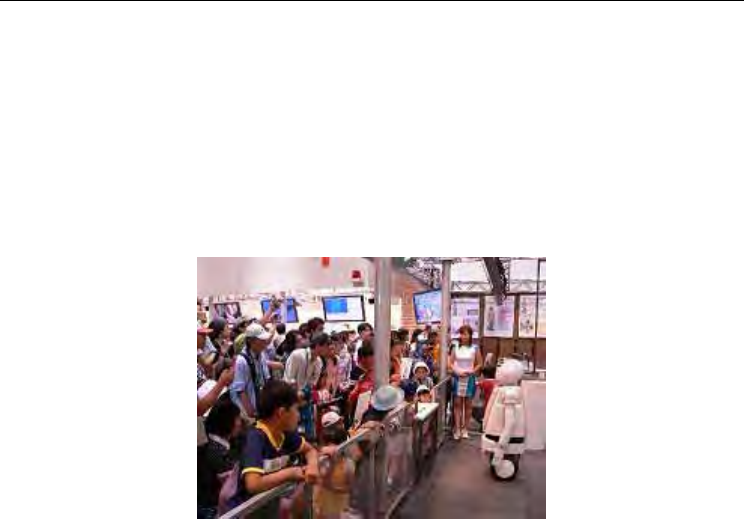
Automatic Speech Recognition of Human-Symbiotic Robot EMIEW
403
Acoustic features are 14-order LPC cepstrum ,14-order delta-LPC cepstrum and 1-oder delta
power. Total dimension of features is 29. This experiment of ASR was done under 5db SNR
(Signal to Noise Ratio) condition. The recognition vocabulary consists of 10-digits. The
number of speakers is 80. The experimental result is shown in Fig. 7. In this experiment,
desired source is in front of the microphone array (azimuth=0 degree). Direction of noise is
variable from 30 degree to 180 degree.
3.4 Demonstration at EXPO 2005 AICHI JAPAN
Appearance of demonstration at EXPO 2005 AICHI JAPAN is shown in Fig. 8. EMIEW
recognized guests’ order under noisy environment (noise level= from 70 db(A) to 80 db(A)).
Figure 8. demonstration at EXPO 2005 AICHI JAPAN: EMIEW recognized guests’ speech
under noisy environment
5. Conclusion
We explained noise reduction technique and automatic speech recognition (ASR) under
noisy environments. Human symbiotic robot EMIEW succeeded recognition under noisy
environment at EXPO 2005 AICHI JAPAN.
For high accuracy of ASR under noisy environment, noise reduction technique is necessary.
In this chapter, robust noise reduction technique with a microphone array was proposed.
Proposed Modified Delay and Sum Beam-Former (MDSBF) can localize sources more
accurately than conventional Delay and Sum Beam-Former (DSBF) . A novel adaptation
method of Minimum Variance Beam-Former (MVBF) with time-variant coefficient (SB-
MVBF) is proposed. Performance of ASR with proposed method was shown to be higher
than conventional MVBF.
6. Acknowledgment
This work was done through entrustment by the New Energy and Industrial Technology
Development Organization (NEDO).

Human-Robot Interaction
404
7. References
Hosoda, Y.; Egawa, S. Tamamoto, J. Yamamoto, K. Nakamura, R. & Togami, M. (2006).
Basic design of human-symbiotic robot EMIEW, Proceedings of IROS 2006, pp. 5079-
5084
Kitahara, Y. (2006). Development of High Quality and Intelligent Speech Synthesis
Technology. Hitachi Review , Vol.88, No. 06, pp. 60-65 (in Japanese)
Boll, S.F. (1979). Suppression of acoustic noise in speech using spectral subtraction, IEEE
Trans. ASSP, Vol.27, No.2, pp. 113-120
Togami, M.; Sumiyoshi, T. & Amano, A. (2006). Sound source separation of overcomplete
convolutive mixtures using generalized sparseness, CD-ROM Proceedings of
IWAENC2006
Frost, III, O.L. (1972). An algorithm for linearly constrained adaptive array processing,
Proceedings IEEE Vol.60, No.8, pp. 926-935.
Griffith, L.J. & Jim, C.W. (1982). An alternative approach to linearly constrained adaptive
beamforming, IEEE Trans. Anntenas Propagation, Vol.30, i.1, pp. 27-34
Aoki, M. ; Okamoto, M., Aoki, S., Matsui, H., Sakurai, T. & Kaneda, Y. (2001). Sound source
segregation based on estimating incident angle of each frequency component of
input signals acquired by multiple microphones, Acoust.Sci & Tech. Vol.22, No.2,
pp. 149-157
Hoshuyama, O. ; Sugiyama, A. & Hirano, A. (1999). A robust adaptive beamformer for
microphone arrays with a blocking matrix using constrained adaptive filters, IEEE
Trans. Signal Processing , Vol.47, No.10, pp.2677-2684
23
Mixed-initiative multirobot control in USAR
Jijun Wang and Michael Lewis
School of Information Sciences, University of Pittsburgh
USA
1. Introduction
In Urban Search and Rescue (USAR), human involvement is desirable because of the
inherent uncertainty and dynamic features of the task. Under abnormal or unexpected
conditions such as robot failure, collision with objects or resource conflicts human judgment
may be needed to assist the system in solving problems. Due to the current limitations in
sensor capabilities and pattern recognition people are also commonly required to provide
services during normal operation. For instance, in the USAR practice (Casper & Murphy
2003), field study (Burke et al. 2004), and RoboCup competitions (Yanco et al. 2004), victim
recognition remains primarily based on human inspection.
Human control of multiple robots has been suggested as a way to improve effectiveness in
USAR. However, multiple robots substantially increase the complexity of the operator’s task
because attention must be continually shifted among robots. A previous study showed that
when the mental demand overwhelmed the operator’s cognitive resources, operators
controlled reactively instead of planning and proactively controlling the robots leading to
worse performance (Trouvain et al. 2003). One approach to increasing human capacity for
control is to allow robots to cooperate reducing the need to control them independently.
Because human involvement is still needed to identify victims and assist individual robots,
automating coordination appears to be a promising avenue for reducing cognitive demands
on the operator.
For a human/automation system, how and when the operator intervenes are the two issues
that most determine overall effectiveness (Endsley 1996). How the human interacts with the
system can be characterized by the level of autonomy (LOA), a classification based on the
allocation of functions between human and robot. In general, the LOA can range from
complete manual control to full autonomy (Sheridan 2002). Finding the optimal LOA is an
important yet hard to solve problem because it depends jointly on the robotic system, task,
working space and the end user. Recent studies (Squire et al. 2003; Envarli & Adams 2005;
Parasuraman et al. 2005; Schurr et al. 2005) have compared different LOAs for a single
operator interacting with cooperating robots. All of them, however, were based on simple
tasks using low fidelity simulation thereby minimizing the impact of situation awareness
(SA). In realistic USAR applications (Casper & Murphy 2003, Burke et al. 2004, Yanco et al.
2004) by contrast, maintaining sufficient SA is typically the operator’s greatest problem.
The present study investigates human interaction with a cooperating team of robots
performing a search and rescue task in a realistic disaster environment. This study uses
USARSim (Wang et al. 2003), a high fidelity game engine-based robot simulator we

Human-Robot Interaction
406
developed to study human-robot interaction (HRI) and multi-robot control. USARSim
provides a physics based simulation of robot and environment that accurately reproduces
mobility problems caused by uneven terrain (Wang et al. 2005), hazards such as rollover
(Lewis & Wang 2007), and provides accurate sensor models for laser rangefinders (Carpin et
al. 2005) and camera video (Carpin et al. 2006). This level of detail is essential to posing
realistic control tasks likely to require intervention across levels of abstraction. We
compared control of small robot teams in which cooperating robots exploring
autonomously, were controlled independently by an operator, or through mixed initiative
as a cooperating team. In our experiment mixed initiative teams found more victims and
searched wider areas than either fully autonomous or manually controlled teams. Operators
who switched attention between robots more frequently were found to perform better in
both manual and mixed initiative conditions.
We discuss the related work in section 2. Then we introduce our simulator and multi-robot
system in section 3. Section 4 describes the experiment followed by the results presented in
section 5. Finally, we draw conclusion and discuss the future work in section 6.
2. Related Work
When a single operator controls multiple robots, in the simplest case the operator interacts
with each independent robot as needed. Control performance at this task can be
characterized by the average demand of each robot on human attention (Crandall et al. 2005)
or the distribution of demands coming from multiple robots (Nickerson & Skiena 2005).
Increasing robot autonomy allows robots to be neglected for longer periods of time making
it possible for a single operator to control more robots. Researchers investigating the effects
of levels of autonomy (teleoperation, safe mode, shared control, full autonomy, and
dynamic control) on HRI (Marble et al. 2003; Marble et al. 2004) for single robots have found
that mixed-initiative interaction led to better performance than either teleoperation or full
autonomy. This result seems consistent with Fong’s collaborative control (Fong et al. 2001)
premise that because it is difficult to determine the most effective task allocation a priori,
allowing adjustment during execution should improve performance.
The study of autonomy modes for multiple robot systems (MRS) has been more restrictive.
Because of the need to share attention between robots, teleoperation has only been allowed
for one robot out of a team (Nielsen et al. 2003) or as a selectable mode (Parasuraman et al.
2005). Some variant of waypoint control has been used in all MRS studies reviewed
(Trouvain & Wolf 2002; Nielsen et al. 2003; Squire et al. 2003; Trouvain et al. 2003; Crandall et
al. 2005; Parasuraman et al. 2005) with differences arising primarily in behaviour upon
reaching a waypoint. A more fully autonomous mode has typically been included involving
things such as search of a designated area (Nielsen et al. 2003), travel to a distant waypoint
(Trouvain & Wolf 2002), or executing prescribed behaviours (Parasuraman et al. 2005). In
studies in which robots did not cooperate and had varying levels of individual autonomy
(Trouvain & Wolf 2002; Nielsen et al. 2003; Trouvain et al. 2003; Crandall et al. 2005) (team
size 2-4) performance and workload were both higher at lower autonomy levels and lower
at higher ones. So although increasing autonomy in these experiments reduced the cognitive
load on the operator, the automation could not perform the replaced tasks as well. This
effect would likely be reversed for larger teams such as those tested in Olsen & Wood’s
(Olsen & Wood 2004) fan-out study which found highest performance and lowest (per robot
activity) imputed workload for the highest levels of autonomy.

Mixed-initiative multirobot control in USAR
407
For cooperative tasks and larger teams individual autonomy is unlikely to suffice. The
round-robin control strategy used for controlling individual robots would force an operator
to plan and predict actions needed for multiple joint activities and be highly susceptible to
errors in prediction, synchronization or execution. A series of experiments using the
Playbook interface and the RoboFlag simulation (Squire et al. 2003; Parasuraman et al. 2005)
provide data on HRI with cooperating robot teams. These studies found that control
through delegation (calling plays/plans) led to higher success rates and faster missions than
individual control through waypoints and that as with single robots (Marble et al. 2003;
Marble et al. 2004) allowing the operator to choose among control modes improved
performance. Again, as in the single robot case, the improvement in performance from
adjustable autonomy carried with it a penalty in reported workload. Another recent study
(Schurr et al. 2005) investigating supervisory control of cooperating agents performing a fire
fighting task found that human intervention actually degraded system performance. In this
case, the complexity of the fire fighting plans and the interdependency of activities and
resources appeared to be too difficult for the operator to follow. For cooperating teams and
relatively complex tasks, therefore, the neglect-tolerance assumption (Olsen & Wood 2004;
Crandall et al. 2005) that human control always improves performance may not hold. For
these more complex MRS control regimes it will be necessary to account for the arguments
of Woods et al. (Woods et al. 2004) and Kirlik’s (Kirlik 1993) demonstration that higher levels
of autonomy can act to increase workload to the point of eliminating any advantage by
placing new demands on the operator to understand and predict automated behaviour. The
cognitive effort involved in shifting attention between levels of automation and between
robots reported by (Squire et al. 2003) seems a particularly salient problem for MRS.
Experiment World Robots Task Team
Nielsen et al. (2003) 2D simulator 3 Navigate/build map independent
Crandall et al. (2005) 2D simulator 3 Navigate independent
Trouvain & Wolf (2002) 2D simulator 2,4,8 Navigate independent
Trouvain et al. (2003) 3D simulator 1,2,4 Navigate independent
Parasuraman et al. (2005) 2D simulator 4,8 Capture the flag cooperative
Squire et al. (2006) 2D simulator 4,6,8 Capture the flag cooperative
Present Experiment 3D simulator 3 Search cooperative
Table 1. Recent MRS Studies
Table 1 organizes details of recent MRS studies. All were conducted in simulation and most
involve navigation rather than search, one of the most important tasks in USAR. This is
significant because search using an onboard camera requires greater shifts between contexts
than navigation which can more easily be performed from a single map display (Bruemmer
et al. 2005; Nielsen & Goodrich 2006). Furthermore, previous studies have not addressed the
issues of human interaction with cooperating robot teams within a realistically complex
environment. Results from 2D simulation (Squire et al. 2003; Parasuraman et al. 2005), for
example, are unlikely to incorporate tasks requiring low-level assistance to robots, while
experiments with non-cooperating robots (Trouvain & Wolf 2002; Nielsen et al. 2003;
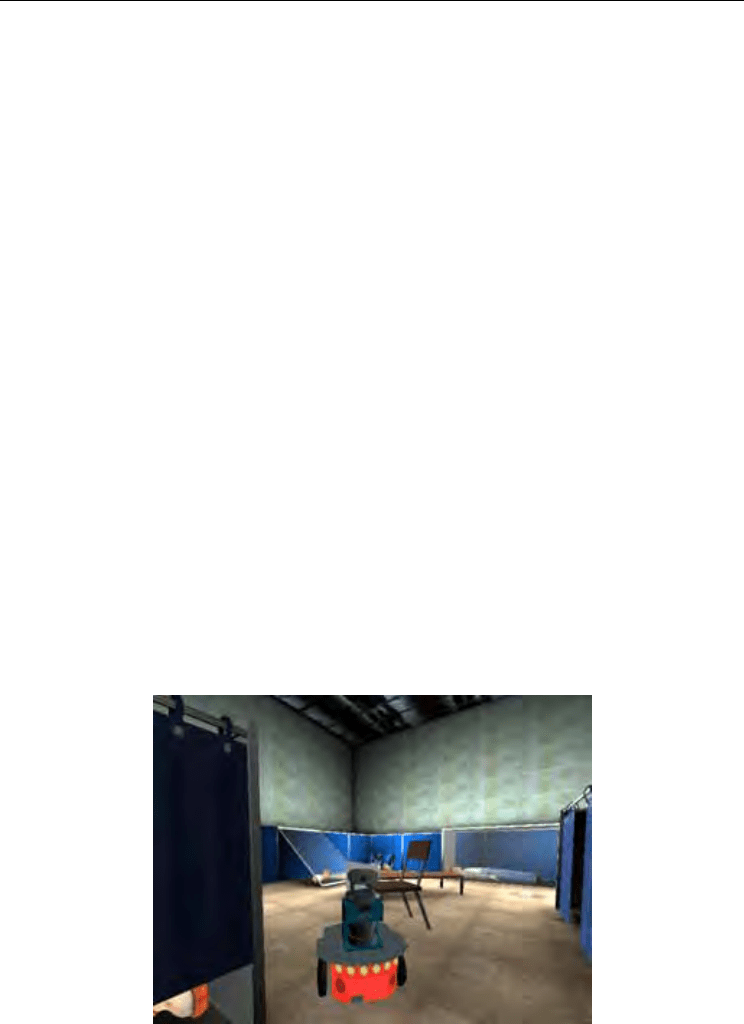
Human-Robot Interaction
408
Trouvain et al. 2003; Crandall et al. 2005) miss the effects of this aspect of autonomy on
performance and HRI.
This paper presents an experiment comparing search performance of teams of 3 robots
controlled manually without automated cooperation, in a mixed-initiative mode interacting
with a cooperating team or in a fully autonomous mode without a human operator. The
virtual environment was a model of the Yellow Arena, one of the NIST Reference Test
Arenas designed to provide standardized disaster environments to evaluate human robot
performance in USAR domain (Jacoff et al. 2001). The distributed multiple agents
framework, Machinetta (Scerri et al. 2004) is used to automate cooperation for the robotic
control system in the present study.
3. Simulator and Multirobot System
3.1 Simulation of the Robots and Environment
Although many robotic simulators are available most of them have been built as ancillary
tools for developing and testing control programs to be run on research robots. Simulators
(Lee et al. 1994; Konolige & Myers 1998) built before 2000 typically have low fidelity
dynamics for approximating the robot’s interaction with its environment. More recent
simulators including ÜberSim (Browning & Tryzelaar 2003) , a soccer simulator, Gazebo
(Gerkey et al. 2003), and the commercial Webots (Cyberbotics Ltd. 2006) use the open source
Open Dynamics Engine (ODE) physics engine to approximate physics and kinematics more
precisely. ODE, however, is not integrated with a graphics library forcing developers to rely
on low-level libraries such as OpenGL. This limits the complexity of environments that can
practically be developed and effectively precludes use of many of the specialized rendering
features of modern graphics processing units. Both high quality graphics and accurate
physics are needed for HRI research because the operator’s tasks depend strongly on remote
perception (Woods et al. 2004), which requires accurate simulation of camera video, and
interaction with automation, which requires accurate simulation of sensors, effectors and
control logic.
Figure 1. Simulated P2DX robot
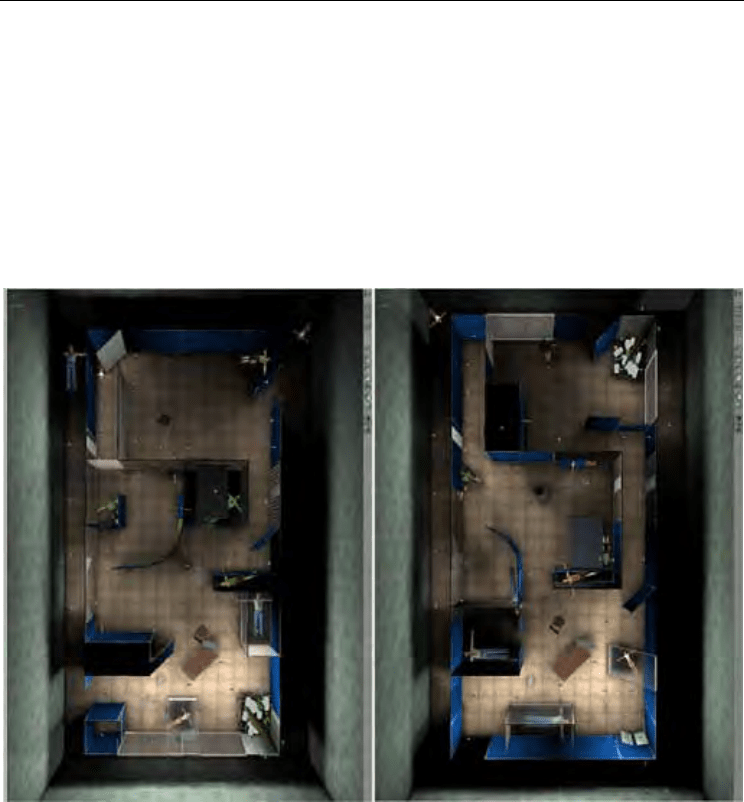
Mixed-initiative multirobot control in USAR
409
We built USARSim, a high fidelity simulation of USAR robots and environments to be a
research tool for the study of HRI and multi-robot coordination. USARSim supports HRI by
accurately rendering user interface elements (particularly camera video), accurately
representing robot automation and behavior, and accurately representing the remote
environment that links the operator’s awareness with the robot’s behaviors. It was built
based on a multi-player game engine, UnrealEngine2, and so is well suited for simulating
multiple robots. USARSim uses the Karma Physics engine to provide physics modeling,
rigid-body dynamics with constraints and collision detection. It uses other game engine
capabilities to simulate sensors including camera video, sonar, and laser range finder. More
details about USARSim can be found at (Wang et al. 2003; Lewis et al. 2007).
a) Arena-1 b) Arena-2
Figure 2. Simulated testing arenas
In this study, we simulated three Activemedia P2-DX robots. Each robot was equipped with
a pan-tilt camera with 45 degrees FOV and a front laser scanner with 180 degree FOV and
resolution of 1 degree. Two similar NIST Reference Test Arenas, Yellow Arena, were built
using the same elements with different layouts. In each arena, 14 victims were evenly
distributed in the world. We added mirrors, blinds, curtains, semitransparent boards, and
wire grid to add difficulty in situation perception. Bricks, pipes, a ramp, chairs, and other
debris were put in the arena to challenge mobility and SA in robot control. Figure 1 shows a
simulated P2DX robot and a corner in the virtual environment. Figure 2 illustrates the
layout of the two testing environments.
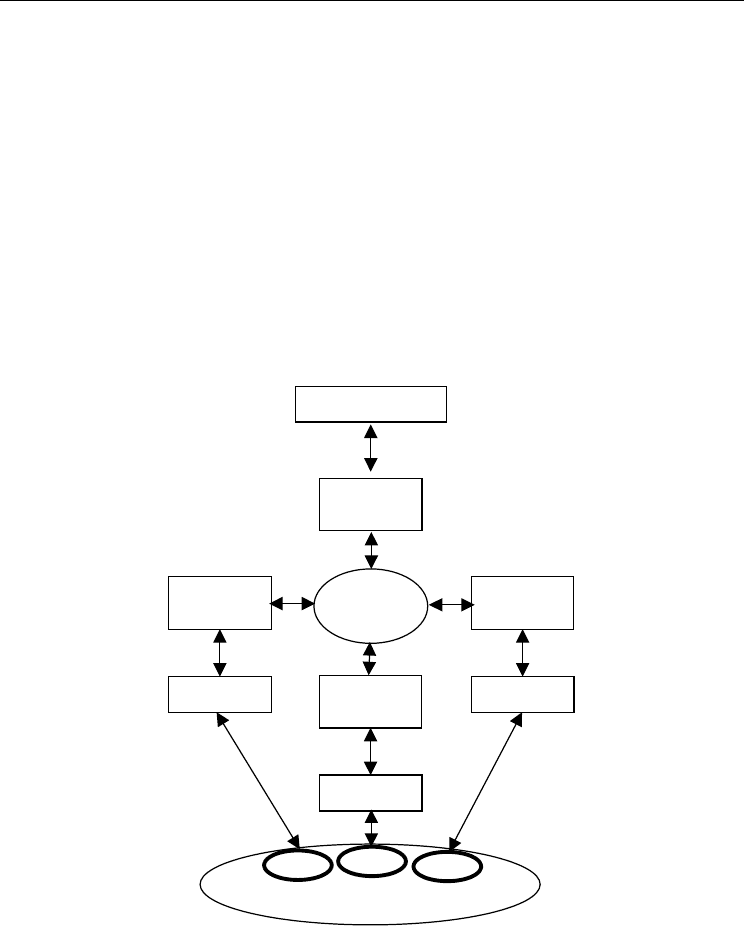
Human-Robot Interaction
410
3.2 Multi-robot Control System (MrCS)
The robotic control system used in this study is MrCS (Multi-robot Control System), a multi-
robot communications and control infrastructure with accompanying user interface. MrCS
provides facilities for starting and controlling robots in the simulation, displaying camera
and laser output, and supporting inter-robot communication through Machinetta (Scerri et
al. 2004). Machinetta is a distributed mutiagent system with state-of-the-art algorithms for
plan instantiation, role allocation, information sharing, task deconfliction and adjustable
autonomy (Scerri et al. 2004). The distributed control enables us to scale robot teams from
small to large. In Machinetta, team members connect to each other through reusable
software proxies. Through the proxy, humans, software agents, and different robots can
work together to form a heterogeneous team. Basing team cooperation on reusable proxies
allows us to quickly change size or coordination strategies without affecting other parts of
the system.
USARSim
Drive
r
Machinetta
Proxy
Drive
r
Machinetta
Proxy
Drive
r
Machinetta
Proxy
User Interface
Machinetta
Proxy
Comm
Server
Robot 1
Robot 3
Robot 2
Figure 3. MrCS system architecture
Figure 3 shows the system architecture of MrCS. It provides Machinetta proxies for robots,
and human operator (user interface). Each robot connects with Machinetta through a robot
driver that provides low-level autonomy such as guarded motion, waypoint control
(moving form one point to another while automatically avoiding obstacles) and middle-
